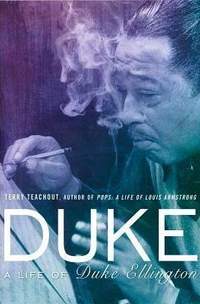Artist Anthologies,
A fascinating Duke Ellington biography by Terry Teachout
I have wanted to get a deeper understanding of Duke Ellington’s music for some time, but until recently I hadn’t got very far beyond the greatest hits in what is a daunting discography. I often find it helps to place music in a historical context, which is why Terry Teachout’s biography Duke: A Life of Duke Ellington is doing such a sterling job of navigating me through. Part of the difficulty with swing era jazz is that it was written to serve a purpose, and either get people dancing or provide the soundtrack for lavish floor shows. Once Parker, Gillespie, Monk, and others came up with bebop, around 1940, jazz musicians finally started to see themselves as artists in their own right, making music that was meant to be listened to, breaking free of the subservient role as entertainers and all of the baggage that implied for African americans. What Treachout’s biography does so well is take us through the industry that Ellington was part of, and outline just how radical the man’s music was becoming, especially when compared to the music of his peers.
 The book also pops some of the myths that Ellington liked to construct around his life, and Teachout especially enjoys pulling apart Ellington’s self-aggrandizing autobiography Music is My Mistress. And yet, despite the numerous affairs, rather stingy writing credits and royalty payments, Ellington emerges from the book as a likeable figure, who paid his musicians well, and they in turn rewarded him with decades of loyalty. And the musicians were the key to his inspiration when composing; he wouldn’t simply write a sax part, he was writing for a specific soloist like Johnny Hodges or Harry Carney (also known as Rabbit or Rab, due to his indifferent demeanour on the bandstand and prominent teeth), or Sonny Greer on drums, Bubber Miley and Cootie Williams on trumpet, trombonists Juan Tizol and Joe ‘Tricky’ Nanton, and radical bassist James Blanton. Teachout paints vivid pictures of the characters in the band, without getting bogged down and halting the flow of the narrative. Ellington’s working relationship with Irving Mills, a one-man manager, publicist, concert promoter and music publisher, is also explored, as Mills was crucial in building the myth of Ellington.
The book also pops some of the myths that Ellington liked to construct around his life, and Teachout especially enjoys pulling apart Ellington’s self-aggrandizing autobiography Music is My Mistress. And yet, despite the numerous affairs, rather stingy writing credits and royalty payments, Ellington emerges from the book as a likeable figure, who paid his musicians well, and they in turn rewarded him with decades of loyalty. And the musicians were the key to his inspiration when composing; he wouldn’t simply write a sax part, he was writing for a specific soloist like Johnny Hodges or Harry Carney (also known as Rabbit or Rab, due to his indifferent demeanour on the bandstand and prominent teeth), or Sonny Greer on drums, Bubber Miley and Cootie Williams on trumpet, trombonists Juan Tizol and Joe ‘Tricky’ Nanton, and radical bassist James Blanton. Teachout paints vivid pictures of the characters in the band, without getting bogged down and halting the flow of the narrative. Ellington’s working relationship with Irving Mills, a one-man manager, publicist, concert promoter and music publisher, is also explored, as Mills was crucial in building the myth of Ellington.
Teachout’s depiction of Harlem and the prohibition era of speakeasies helps us understand the world Ellington was working in - like the reality of The Cotton Club, Ellington’s most steady engagement, where black entertainment was provided exclusively for a whites-only audience, and yet paid Ellington and his men top salaries for their services. As the book progresses Teachout charts Ellington’s growing outrage at the inequalities in American life, and the development of the long form protest piece Black, Brown and Beige which was premiered at Carnegie Hall in 1943.
At the heart of the book is Teachout’s evident love of Ellington’s music and his enthusiastic descriptions of the creative process in creating a classic tune, making me put the book down at regular intervals and listen to the tracks like East St-Louis Toodle-oo, Black and Tan Fantasy, The Mooch, and Creole Love Call with a fresh perspective. I see that Teachout has also written a Louis Armstrong biography, which will be next on my reading list.



